As the Americans bombed Ukraine. Part I
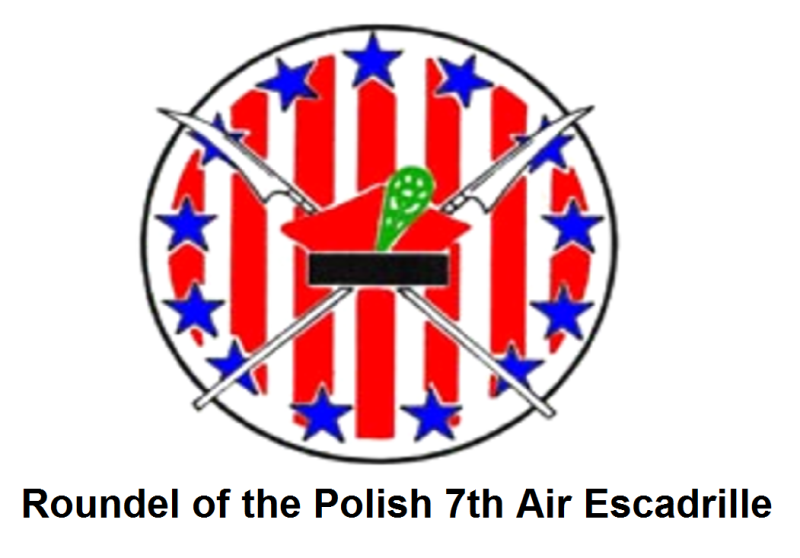
This statement may seem ridiculous to some, but the fact remains that such dear American friends to the Ukrainian heart, or rather, their ancestor ancestors, managed to fight the Ukrainians, and even in the first years of national awakening. What led overseas pilots to the Ukrainian sky in those years? The same as usual - a passion for different historical missions on foreign continents. Here is how it was.
After World War I, various overseas missions were sent to the territories bordering on our country or formerly part of it. The latter were often associated with humanitarian goals - food or medical care, but were largely composed of military personnel. At the very beginning of 1919, they also appeared on lands occupied by the Polish-Ukrainian armed conflict. 4 January 1919, the mission of the ARA Hoover Organization (American Administration of Assistance to the Countries of Central and Eastern Europe) arrived in Warsaw. The ARA was created in 1919 year, headed by the future (1929-1933) by US President G. Hoover. The proclaimed goal is to provide food, as well as other assistance to countries ravaged by the First World War. Those. Americans in those days declared the same slogans as they are today. And just like now, the activities of the ARA in 1919 -1920. not limited to the official framework.
Its representatives often intervened in social and national conflicts that took place in this part of the continent. And immediately after the audience that day, Pilsudski determined one of the main lines of action for missionaries. They became Western Ukrainian lands, where the Polish-Ukrainian armed conflict flared up more and more. In early February, a permanent mission unit was opened in Lviv. In March, he was led by the captain aviation Merion Cooper. Communication with Lviv, where the Poles managed to stay, was supported by troops. Here is how Cooper himself recalled this: “The railway line and other lines of communication were cut off by the Ukrainians. But I continued to move forward, making my way with the battalion of the Poznan Poles. We opened the movement by rail and by other routes after a fierce two-day battle ... "
These battles were fought with detachments of the Western Ukrainian People's Republic (ZUNR), which operated in the camp of the opponents of Soviet power in Ukraine, but the Poles and Cooper who fought on their side portrayed it as if they were fighting the Bolsheviks and therefore need urgent full support. . In fact, it was about more - to ensure the further deployment of aggression to the East. The desire to directly participate in it and determined the creation of an air squadron. In May, the 1919 of the year, when the “Haller’s army” deployed from France ensured the capture of all Eastern Galicia and Volhynia by Polish troops, M. Cooper found his supply mission in Lviv completed. In a report to the command of the US US Expeditionary Forces in Europe, he requested an appointment to the post in the air force or in the infantry in Arkhangelsk, where American troops fought with the Red Army.
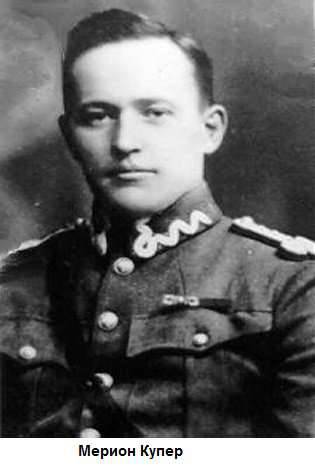
In the USA, it was considered expedient to entrust Cooper with the tasks associated with the organization in Poland of military aviation, the situation of which worried both Warsaw and the West. Two weeks before Cooper's appeal, a review of the state of the Polish armed forces noted that the Polish air fleet is in a deplorable situation: for example, in Kovel, only one of the existing 15 vehicles is suitable. Cooper was recommended to stay in Lviv.
After a meeting with Pilsudski and a thorough discussion at the headquarters of Polish aviation, which was experiencing an acute shortage of its own pilots, an action plan was agreed upon. Cooper was to go to Paris and recruit a squadron of experienced pilots. The American captain was confident that he would be able to return from a squadron of pilots that was ready for the conduct of military operations, with combat experience in France and capable of eliminating the gap created by the inevitably slow and costly formation of the warhead. For two days Warsaw was actively communicating with Paris by telegraph. The approval of the American command was received, and Merion Cooper went by direct express to the capital of France. He took an active part in the formation of the future squadron. Her commander was Major Fauntleroy.
The meeting of Cooper and his future boss was planned and prepared for a long time. The US envoy to Poland X. Gibeon told this to the New York Times in June 1920. Extracts from Fauntleroy's letters were also published there. It turns out that the two pilots met before the arrival of Cooper in Poland. By all means, Fauntleroi sought to lead the American squadron in order to head to Arkhangelsk, and if not succeed, then form a squadron to join the Poles. By the time of the new meeting, Fountleroy managed to conclude a contract with the Polish military mission in Rome. As head of the United States Aviation Engineering Service in Europe, he headed to Warsaw as a technical advisor to the Polish air force. Poland was provided with tangible assistance, but the Americans did not forget themselves. After all, it was about acquiring a new front-line experience, as well as about testing in the real combat situation of aircraft of the newest brands that appeared in various countries only towards the end of the world war.
The disposition, however, was changed. Fountleroy, along with Cooper, set about completing the squadron. He obtained the necessary powers from a recent acquaintance of Cooper in Lviv — the head of the Polish military mission in France, General T. Rozwadowski. In mid-August 1919, the status of American military pilots in the Polish service was finally approved. In addition to American officers, Colonel G. Howland, the US military representative in France, was also directly involved in working out the required position. According to the document, the flight crews were to be composed by American pilots, and the service personnel were Polish. In addition, the provision clearly stipulated that the squadron was created solely for the conduct of combat operations at the front, and its pilots could not be recruited for instructor, training or other work. The squadron being formed was only part of the “Polish-American forces” that were planned to be created. Squadron pilots had to be paid according to the rates existing in the Polish army before the creation of the Polish-American Legion, when the remuneration had to be increased in order to comply with the order in the American army. Prior to this, the difference between the salaries existing in the Polish and American armies should have been determined and paid to officers from the moment the legion was formed. It was not possible to create a “Polish-American Legion”, so to speak, in its pure form. The issue of recalculation was decided after the end of hostilities.
The first was recruited by Lieutenant Crawford. He had just returned from Latvia, where he was a member of the hoover school. In Riga and Mitau (Jelgava) he was doing the same thing as Cooper in Lviv. Almost simultaneously, Crawford's friend, Lieutenant Shresbury, was identified in the squadron. In search of pilots, Cooper headed for England, where American expeditionary forces were also stationed. There were two difficulties that had to be overcome when recruiting a squadron. First, the majority of survivors of the war did not at all seek to continue it voluntarily. Given the massive anti-war sentiments in the United States, expeditionary forces were being demobilized and returned home quickly. By mid-June, more than 1919 million soldiers and officers left Europe for the ocean from Europe over the ocean. Secondly, the requirements for going to Poland were quite high. For a relatively long time, for example, the search for an observer pilot, the chief specialist of a squadron on bombing, took place. He was the captain Kelly from the famous 1,3 squadron, who arrived from behind the English Channel. The New York Times wrote about him as the lead observer in the American army.
In mid-September, the formation of the flight military unit was almost completed. Two more squadron members were missing. However, time rushed. The American aviators visited the reception of Polish Prime Minister I. Paderevsky, who was then in Paris, who later glorified Fauntleroy and his subordinates. A traditional farewell dinner was also held, at which, among others, was attended by the Chief of Staff of the US Expeditionary Forces, General E. Bus. The squadron transfer scheme was also corrected. Initially, the transportation was taken over by the Polish government. However, the American command chose not to publicize the sending of its military pilots to the Polish-Soviet front. Colonel Howland organized it.
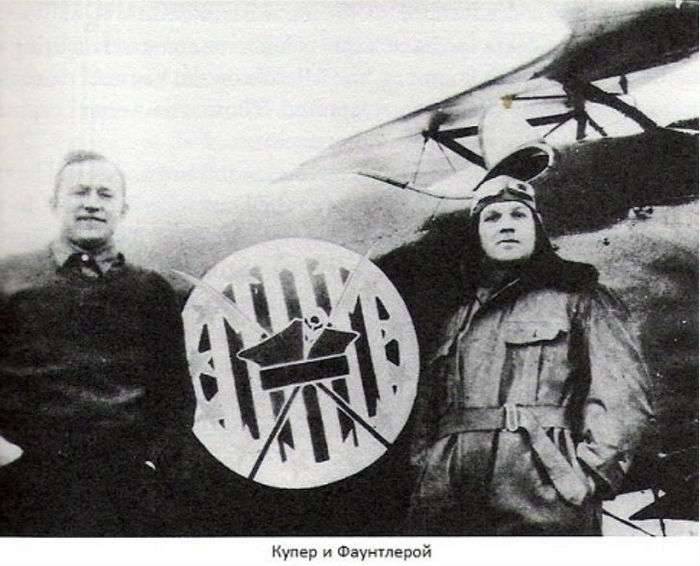
An open crossing through Germany seemed too risky. The US pilots disguised as ordinary US Army officers proceeded to Koblenz on the American Red Cross train, from there to Warsaw on the American Typhus Mission, which passed unhindered, and where only two top members of the US medical corps knew about the true purpose of the imaginary privates. After traveling a week, the 23 pilots of September 1919 of the year arrived in Poland, where the squadron commander Fountlera was already stationed, and settled down at the Mokot capital airfield.
Looking ahead, let's say that in 1925 in the overseas magazine the essays of one of the American pilots - K.M. Murray "Squadron Kosciuszko", seven years later they composed a voluminous book "Wings over Poland." More than four decades later, Robert F. Karolewitz and Ross S. Fenn released The Flight of the Eagles. The history of the Kosciuszko American squadron in the Polish-Soviet war 1919 - 1920. ”
On the pages of the book of Murray, describing the stay of American pilots in Warsaw, is full of statements about the threat of Bolshevism. But even through the usual and standard ideologizing, genuine details of the private pastime of American pilots made their way through. Some of their impressions are embedded in the text. “A lot can be said,” the author narrates, “about a honey-hop drink, a dark, heavy wine made from natural honey, especially if it has been aged for centuries.” And later, Korolevitz and Fenn later regretted: “Warsaw was not at all like the Paris of early fall of 1919. There was more fun and freedom”.
Pilots Squadron 14 October 1919, the year in Belvedere J. Pilsudski. Although he stated that he was a cavalryman and an aircraft for him, the 15 was already officially announced to the Americans in the morning: they are going to Lviv, where, as a “Kosciusko squadron,” they will be part of the Polish Army’s 2 air group. This meant that Pilsudski placed the American squadron in the main direction of the upcoming "campaign against Kiev".
Arriving in the morning of October 17 at their destination, the Americans began preparing aircraft for future combat operations. Albatros and Fokkers, remaining from German and Austro-Hungarian aviation, were put in order and re-equipped. On the "Albatross D-3" was put on two machine guns and improved bombing devices. However, the main calculations were on military aircraft of the Allied armies.
Fauntleroi continuously traveled between Lviv and Warsaw, falling asleep in Warsaw military and diplomatic missions with requests to quickly send the latest types of military aircraft to American pilots. These requests were quickly and readily satisfied. In the squadron, the French "Breguet", the Italian "Balily" appeared, weapons were supplied in abundance, and gasoline varieties were carefully selected. The squadron was divided into two links. One was commanded by Captain Corsi, the other by Cooper.
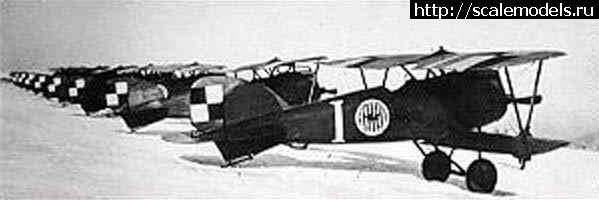
In late autumn, Pilsudski arrived in Lviv. He inspected the troops preparing for aggression. During the parade in honor of Pilsudski, an American military squadron flew in the skies of Lviv. But here the organizers of the parade awaited confusion - one of the fighters was wrecked, the pilot E. Graves died. However, on November 30 Lieutenant Rorison arrived in his place.
Not everyone welcomed the new armed uprising against Soviet Russia. Uninvited "guests" of Lviv were soon able to feel the real attitude of Western Ukrainian and Polish workers who sympathized with the Bolsheviks. The airfield hangar where the squadron aircraft were stored burned down. In response, they doubled their guards, carried out brutal repressive actions against the local population. However, this did not work. Soon the aircraft repair workshops and weapons and equipment warehouses were burned. Burnt military property, according to the "chronicler" of the American squadron, was estimated at hundreds of thousands of dollars. Murray tried to assure that the incident was the case of “Soviet agents disguised as Polish workers,” but documents released in the nineties indicate that the “Soviet agents” were not involved.
In preparation for the military campaign, the Polish command sought to save American pilots. Polish historians even argued that the squadron should be in reserve until the very beginning of the attack on Kiev. In the winter of 1919 - 1920 the Polish government, without declaring war, actually did not cease hostilities against the Soviet republics. In the winter and spring of 1920, they were most actively pursued in Ukraine. And here American military pilots were actively used.
They tried, first of all, to create a forward base of the squadron closer to the front line. At first, such calculations were related to Kamenets-Podolsky. It remained the only city east of Zbruch, where the remnants of the forces of the defeated nationalist Ukrainian army were concentrated (its head Petlyura with his closest entourage was in Warsaw, wards Pilsudski himself). Plans to “cling” to the Ukrainian territory were shared by all the powers involved in the Russian intervention. Cooper delivered to Kamianets-Podilsky a member of the British military mission in Poland - Major Holmes. After staying here for four days, in December 1919, the American and the Englishman returned.
For a longer time, the pilots were redeployed by its pilots - first for two weeks, including the Christmas holidays, Crawford and Shresbury, and then from January 7, 1920, Roorison and Noble. The results were extremely disappointing. “Gentlemen of Fortune” immediately discovered, Murray recalled that the population of Kamenets experienced a frankly hostile, albeit pent-up attitude to Polish officers and soldiers who were secretly concentrated here. Soon, these sentiments began to grow into open speeches against the Petliura authorities and their Polish patrons. Returning to Lviv, Rorison and Noble reported that Kamyanets-Podilsky was in fact embraced by a general uprising. On the streets, firefights periodically flare up. The creation of an airfield here is excluded until the ground forces crush the demonstrations and establish firm armed control over the city. Despite the increasingly active overt intervention of the Poles, the Ukrainian bourgeois-nationalist forces turned out to be too unreliable cover for creating an outpost of American aggression. It was decided to locate the airfield near the shock military base of the Poles, located in Ternopil.
With the passage of time, the true goals of interventionist actions were revealed more clearly. In December, Colonel Benjamin Castle, who arrived from overseas, visited the squadron of 1919. This representative of a major New York banking house experienced its own serious problems in trying to establish banking in Eastern Poland. The main enemy of "normal" financial operations in Western Ukraine proclaimed a strong Soviet influence. The essence of the matter was that the adventurers in the Ukrainian sky were once again unequivocally reminded: behind the aggression against Russia there were financiers who had grown rich during the years of the world war. They will be able to provide the squadron everything that is needed, and "gentlemen of fortune" will receive a generous reward. (As we can see, little has changed in this over the past hundred years). Thus, the main source of the very “recalculation” that the American air mercenaries were counting on and which more than compensated for the low rate and instability of the Polish currency, came into effect.
Around the same time, Faulttler requested assistance in the United States. “We need twelve enthusiastic pilots, good pilots, gentlemen,” telegraphed from Lviv. Further, reporting on the conditions of payment for participation in air robbery, Fountleroy explained: “Scout pilots are preferable. We can offer only lieutenant positions. Can the American Ballooning Club provide assistance? ”
In fact, aerial reconnaissance was of particular importance in the preparation of aggression. The planes flew not only in the direction of Kiev, where the main attack was planned, but also to the south. In one of the first reports of the Associated Press about the fighting of the American squadron, published by the US newspapers, it was told about the "success of the Poles on the southern front in Podolia", about "the capture of Bar by the Poles to the north-east of Kamyanets-Podilsky". Next came the official communiqué of the Polish Ministry of War 2 on April 1920 of the year, which was based on data obtained by American aviators, “observing an intensive redeployment of fresh red troops on the Podolsk front. Last words - in line with the propaganda training of aggression. The following phrase has already quite accurately characterized the meaning of the activities of US pilots: “The reference in the communique on air operations means that the Kosciusko squadron, commanded by Major Cedric Faulttler, takes part in the battles. This squadron consists of Americans who fought in France, and after the war they became soldiers of fortune in Poland. ”
Active aerial reconnaissance of the southern direction of future aggression and further, towards Odessa, seemed especially important, because the Poles, firstly, were afraid of strikes from the flanks and, secondly, hoped to gain a foothold on the Dnieper, turn south and meet the landing force on the Black Sea coast interventionist powers, as well as the White Guard armies of Wrangel. These three groups were supposed to make a powerful fist of the general offensive against the red Moscow.
The combat missions assigned to American military pilots were determined by the “straightening” of the front that began in the early spring of 1920 and captured convenient bridgeheads for the deployment of a “big war”. As early as March 5, the Polish aggressors seized the important railway junctions Mozyr and Kalinkovichi in Belarus, severing communications between the Western and Southwestern fronts. At the same time, US aviators bombed Soviet units near the city of Bar. Immediately intensified offensive in Ukraine.
In these difficult conditions, Moscow did not stop searching for peace. March 6 Commissar for Foreign Affairs of the RSFSR GV Chicherin sent a note to the Polish Foreign Ministry, in which our country expressed regret about Poland’s refusal to start peace talks, and it was reported that the Russian and Ukrainian Governments were now forced to take all necessary measures to protect Ukrainian territory against an unjustified Polish attack.
11 March 1920, the American pilots relocated closer to the front line in Mikulinz (south of Ternopil). On the same day, as historians of the US air squadron note, official negotiations resumed in Warsaw with representatives of the authorities of the Ukrainian People’s Republic (UNR), which was defeated in the struggle against Soviet power in Ukraine. The same authors note that the motive for which Pilsudski had signed with Petliura was the desperate need to get at least one active ally for a renewable military campaign. Its main object was Ukraine. The Polish government stepped up its course on the deployment of the anti-Soviet war. In late March, the American air squadron, having been in the vicinity of Rovno, relocated to Polonnoe, a town located in close proximity to the front line. Other Western emissaries also arrived here. One of the leaders of the American Red Cross mission, Major Holmes, explained to the aviators the route of the upcoming offensive. After that, during a reconnaissance flight over Zhytomyr and Berdychiv, American pilots fired at civilians, settlements, where there were no military facilities. In principle, this differed little from the behavior of American helicopter pilots in Yugoslavia, Iraq and other countries, where the USA “brought democracy”.
Two days after arriving at Polonnoye, the American airborne mercenaries were ordered to strike at the headquarters of the Red Army division near the Chudnov railway station and the bridge over the Teterev river. Polish troops have not yet begun large-scale hostilities, and the US military pilots have already acted. And again it is difficult to get away from analogies with the events of a very recent past.
The flight to Chudnov was carried out by the five pilots, led by Fauntler. "One by one," Murray reported, choking with delight, "the planes with a roar rushed down, causing death and destruction." "The command," he says further, "was delighted with the success of the attack."
This raid, made by pilots from the United States, was supposed to precede ground operations by the Polish army to seize the city and the railway station. But the Poles did not manage to capture Miraculous, since the bombing did not have the desired effect on the morale of small Soviet units.
Joint actions of the American military aviation and the Polish troops on Chudnov were repeated more than once. However, these attacks were only preparation, and not the beginning of the attack on Kiev, which was carefully prepared. American pilots carried out an intensive overflight on the direction of future strikes. However, intelligence campaigns could not satisfy the thirsty for blood and the thrill that overseas pilots believed in their own impunity. The squadron pilots attacked the position of the Red Army, but more often destroyed civilians. The same Murray testifies that they constantly flew over Soviet territory, having one or two bombs and full ammunition for machine guns. The objects of their attacks were all the same Chudnov, later - Zhytomyr, Radomyshl, and then the turn came in Kiev.
On April 19 for the first time an American plane flew over Kiev, which dropped bombs. As a result, 10 people were killed and 14 injured. Among those killed was a woman and two children. At that time, the Soviet authorities did not yet know that the attacks on peaceful Ukrainian cities and villages were made by Americans.
Today, without embarrassment, American researchers tell about this. For example, N. Davis, who draws attention to the special role of the Polish-Soviet war in the development of military aviation. He emphasizes that air superiority was one of the reasons that enabled Polish troops to avoid dangerous clashes with our army.
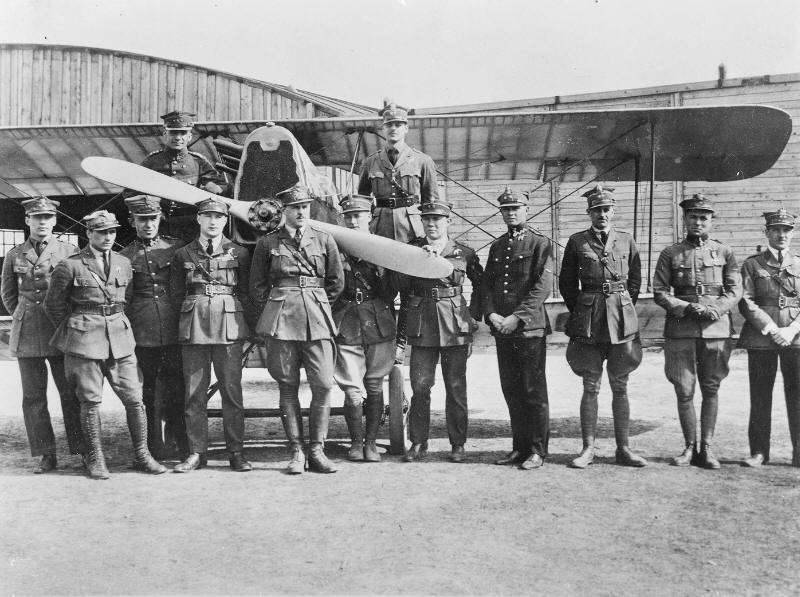
Particularly indicative of the actions of the 7 th (named Kosciusko) squadron. The eve of the Piłsudski campaign on Kiev was characterized by the feverish activity of the American pilots. The 7 Squadron refined the positions that were occupied by the few Red Army units opposing the Polish invasion. However, it was not easy. The decade before April 25 - the day the attacks on Ukraine began - the time of accidents and increasing difficulties. To put the squadron in order, 23 April was announced free of flight day. With the beginning of the offensive, the role of aviation sharply increased. Having a serious combat experience of operations on the Western Front, the latest military equipment at that time, and unlimited possibilities to replenish it, the American pilots became the strongest and most active aviation unit of the Poles. And it is constantly taken into account by the command. In addition to the American one, he had two more fighter and one bomber squadrons at his disposal. The latter was soon also subordinated to the Americans. With the continued support of influential US missions that were in Ukraine in the spring and summer of 1920, the American pilots acted autonomously in some cases, without being particularly concerned with military command.
To be continued.
Sources:
Kuzmin N. The collapse of the last campaign of the Entente. M .: State publishing house of political literature, 1958. C.42-76
Yu. Ivanov. Essays on the history of Soviet-Polish relations 1917-1945. // Our contemporary. 2003 №10. C.38-46
Shestakov V. As the Americans bombed Ukraine. // Alarm No. 11 (166) from 30 March 2007.
Temirov Yu., Donets A. Americans in the Soviet-Polish War // Encyclopedia of Errors. M.: Eksmo; SKIF, 2004. C.6-9
Simonenko R. American pilots in Ukraine. // visage 1993. No.2. C. 46-49.
Meltyukhov M. Soviet-Polish War. Military-political confrontation 1918-1939 M .: Veche, 2001. C.30-48
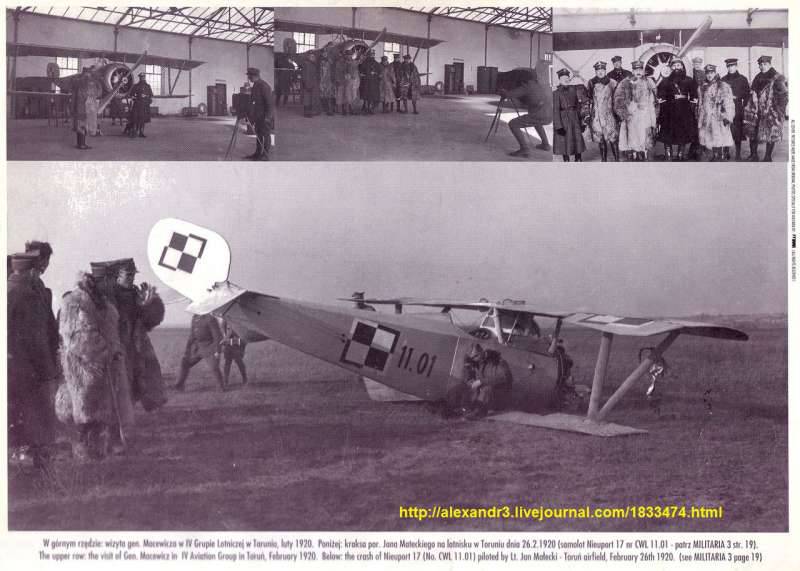
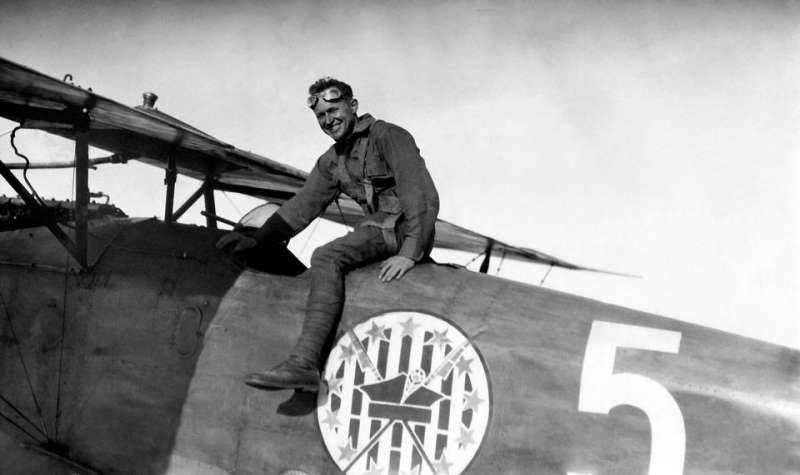
Information